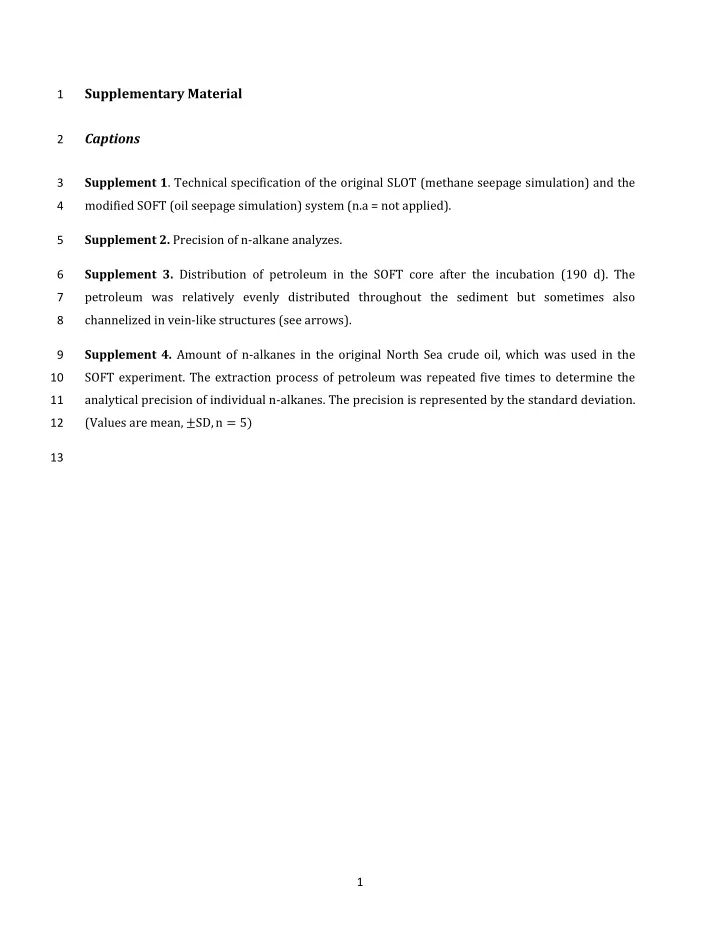

Supplementary Material 1 Captions 2 Supplement 1 . Technical specification of the original SLOT (methane seepage simulation) and the 3 modified SOFT (oil seepage simulation) system (n.a = not applied). 4 Supplement 2. Precision of n-alkane analyzes. 5 Supplement 3. Distribution of petroleum in the SOFT core after the incubation (190 d). The 6 petroleum was relatively evenly distributed throughout the sediment but sometimes also 7 channelized in vein-like structures (see arrows). 8 Supplement 4. Amount of n-alkanes in the original North Sea crude oil, which was used in the 9 SOFT experiment. The extraction process of petroleum was repeated five times to determine the 10 analytical precision of individual n-alkanes. The precision is represented by the standard deviation. 11 (Values are mean, ±SD, n = 5) 12 13 1
Suppl. 1 14 Specification SLOT SOFT (Steeb et al. 2014) (this study) Methane supply from via advection n.a* below Crude oil supply from n.a* via advection below Sulfate supply from top via diffusion Oxygen supply from top n.a* via diffusion (supplied by air pump) Seawater medium Anoxic sulfate-rich Oxic seawater prepared from sea salt delivered from top artificial seawater (Sigma Aldrich), salinity 12 psu medium (Widdel & Bak, 1992), salinity adapted to the respective environment Anoxic, sulfate-free Seepage medium n.a* artificial seawater delivered from bottom medium (Widdel & Bak, 1992), salinity adapted to respective environment Sediment core liners Polycarbonate core liners: gastight, total length 30 cm, inner diameter 6 cm, outer diameter 6.8 cm Sampling holes in core 3 vertical lines of 21 sampling holes (diameter 4 mm, distance liners between sampling holes 5.8 mm) sealed with residue-free silicon (Aquasil, Probau) Pore water sampling Rhizons Peristaltic pumps Medorex TL/10E, min/max pump volume 0.1/400 μ L min -1 Peristaltic pump tubes Santropen; autoclaveable, highflexible, very resistant; tubes inner diameter 0.5 mm, outer diameter 1.6 mm Connecting tubes Iso-Versenic: autoclavable; very resistant; very low gas permeability; inner diameter 1 mm; outer diameter 3 mm Bottom sealing PVC caps Rubber stoppers with 2 oil channels Top sealing PVC cap PVC ring covered with parafilm *n.a = not applied 15 16 2
Suppl. 2 17 n-alkane Standard deviation [%] Standard deviation [%] n=4 n=5 (Method precision from (GC-MS precision for a extraction to measurement) standard mix of 1 ng/µL) n-Decane (C-10) 38.9 2.2 26.3 n-Dodecane(C-12) 4.7 29.9 n-Tetradecane(C-14) 6.1 6.1 n-Hexadecane(C-16) 1.4 3.2 n-Octadecane(C-18) 1.4 2.8 n-Eicosane (C-20) 1.2 2.8 n-Heneicosane (C-21) 1.3 2.4 1.1 n-Docosane (C-22) 2.5 1.1 n-Tetracosane (C-24) 3.5 1.2 n-Hexacosane (C-26) 3.5 1.1 n-Octacosane(C-28) 2.6 1.2 n-Triacontane (C-30) 3.6 1.3 n-Dotriacontane (C-32) 4.3 1.2 n-Tetratriacontane (C-34) 4.3 1.4 n-Hexatriacontane (C-36) 6.0 n-Octatriacontane (C-38) 2.0 18 19 3
Suppl. 3 20 21 22 Suppl. 4 23 24 25 References 26 Widdel, F. and Bak, F. (1992). “ Gram-negative mesophilic sulfate-reducing bacteria, “ in The 27 Prokaryotes . Springer New York, 3352-3378. doi: 10.1007/978-1-4757-2191-1_21 28 29 4
Recommend
More recommend